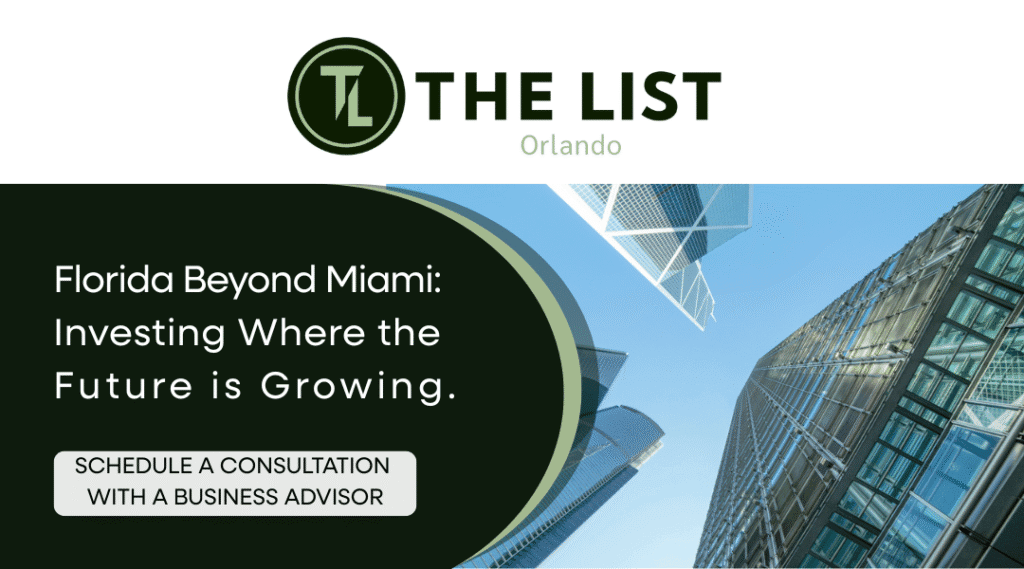
Florida has always been synonymous with growth, opportunity, and resilience. For decades, Miami and Orlando have dominated the headlines when it comes to commercial real estate investment, attracting developers, entrepreneurs, and international investors from every corner of the world. Miami dazzles with its skyline, global financial presence, and cultural diversity, while Orlando continues to thrive thanks to its world-class tourism sector and expanding tech ecosystem. Yet the Sunshine State is much more than its most famous cities. As we move into 2025, a new wave of investment opportunities is emerging in regions that once flew under the radar but are now becoming strategic hotspots for commercial real estate.
The landscape of Florida is shifting, driven by population growth, infrastructure expansion, affordability, and demographic trends that favor markets once considered secondary. Cities like Ocala, Lakeland, Palm Coast, and Cape Coral are capturing the attention of savvy investors who recognize that the future of commercial real estate in Florida is being written in places beyond Miami and Orlando. These rising markets combine strong fundamentals with untapped potential, offering both stability and long-term appreciation. For developers and investors looking for insider knowledge, understanding these emerging markets is key to staying ahead of the curve.
Why Emerging Cities Matter in 2025
In commercial real estate, timing is everything. The investors who achieve the highest returns are often those who identify growth markets before they become saturated. Emerging cities represent that sweet spot: areas where infrastructure, population, and economic expansion are converging but where property values have not yet reached their peak.
Florida’s population boom has fueled demand across the state, and while major cities remain attractive, they are also increasingly expensive and competitive. Investors seeking higher yields are now turning to cities with more affordable entry points, higher cap rates, and growing demand for retail centers, industrial space, office developments, and multifamily housing. The trends pushing people and businesses toward these emerging areas—such as affordability, lifestyle, and accessibility—are not temporary. They are structural changes shaping the state’s future.
For international investors, this means Florida is no longer just about Miami condos or Orlando resorts. The broader state offers opportunities to diversify portfolios, hedge against volatility in saturated markets, and participate in the growth of communities that are still in the early stages of their commercial real estate lifecycle.
Ocala: Florida’s Equestrian Capital Becoming a Commercial Powerhouse
Ocala has long been known as the Horse Capital of the World, home to world-class equestrian facilities and a lifestyle that attracts horse enthusiasts from across the globe. But in recent years, Ocala has transformed from a niche market into a thriving commercial hub. Its strategic location in Central Florida—just north of Orlando and within driving distance of Tampa—makes it a natural crossroads for logistics and distribution.
The expansion of the I-75 corridor has amplified Ocala’s appeal as a logistics center. Industrial developers are increasingly drawn to the region, and warehouses, distribution centers, and related commercial projects are multiplying. National retailers and e-commerce giants are recognizing the value of Ocala’s location, leading to steady job creation and further demand for commercial properties.
At the same time, Ocala’s affordability continues to attract new residents, fueling demand for multifamily housing, healthcare facilities, retail centers, and professional offices. With population growth comes the expansion of services and infrastructure, which in turn creates fertile ground for investors seeking stable returns. While the equestrian lifestyle remains a cultural and economic driver, Ocala has become much more than horses. It is now one of Florida’s most promising commercial real estate frontiers.
Lakeland: The Logistic Heart of Florida
Situated between Tampa and Orlando, Lakeland has always had a geographic advantage. But in recent years, it has leveraged this position to become one of Florida’s premier logistics and distribution hubs. With access to major highways, rail connections, and proximity to two international airports, Lakeland has attracted some of the largest industrial developments in the state.
Companies such as Amazon, Publix, and FedEx have established significant operations in Lakeland, cementing its reputation as a logistics powerhouse. This corporate presence not only drives demand for industrial real estate but also sparks a ripple effect across the community. More jobs bring more residents, who in turn create demand for retail, healthcare, hospitality, and multifamily housing.
Lakeland also benefits from being more affordable than its neighboring metros. For investors priced out of Tampa or Orlando, Lakeland offers strong fundamentals without the inflated costs. The city’s steady population growth, coupled with its industrial base, makes it a reliable market for long-term commercial investments. Developers are eyeing mixed-use projects, retail centers, and even office developments, confident that Lakeland’s trajectory is only going upward.
Palm Coast: Growth on Florida’s Atlantic Edge
Nestled between Jacksonville and Daytona Beach, Palm Coast is one of Florida’s fastest-growing cities. What once was a quiet coastal town has evolved into a thriving residential and commercial community, attracting retirees, families, and businesses alike. With its scenic location along the Atlantic Ocean and its relatively affordable real estate, Palm Coast has become a magnet for people seeking both lifestyle and value.
For investors, Palm Coast offers a unique blend of opportunities. The city’s growth is fueling demand for healthcare facilities, retail spaces, and professional offices. Its coastal location also makes it attractive for hospitality projects, from boutique hotels to restaurants and marinas. At the same time, population growth is creating sustained demand for multifamily developments and mixed-use projects that combine residential and commercial elements.
Palm Coast is particularly appealing to investors looking for markets with high growth potential but relatively low saturation. While Miami and Jacksonville may dominate headlines, Palm Coast offers a quieter but equally lucrative path, with fundamentals that suggest steady appreciation. As infrastructure expands and the city continues to attract new residents, commercial real estate in Palm Coast is poised to deliver strong long-term returns.
Cape Coral: Southwest Florida’s Rising Star
Cape Coral, located near Fort Myers, has experienced one of the fastest population growth rates in Florida over the past decade. Known for its extensive canal system, Cape Coral offers a unique lifestyle that combines waterfront living with affordability, making it highly attractive to retirees, families, and remote workers. This demographic expansion has created enormous demand for commercial development.
Retail centers, healthcare facilities, and hospitality projects are flourishing in Cape Coral, driven by both local demand and seasonal tourism. Multifamily housing is also expanding rapidly, as developers respond to the influx of new residents. The city’s proximity to Fort Myers further enhances its appeal, offering investors access to a broader regional market.
Cape Coral’s growth story is still in its early chapters. While it has experienced rapid residential expansion, the commercial side is only beginning to catch up, creating opportunities for investors to enter before full maturity. With population growth projected to continue for years, Cape Coral stands out as a city where commercial real estate can thrive.
Beyond the Big Four: The Ripple Effect
While Ocala, Lakeland, Palm Coast, and Cape Coral represent some of the most promising emerging markets in Florida, they are not alone. The ripple effect of growth across the state means that other secondary and tertiary cities are also gaining momentum. Gainesville, Port St. Lucie, and Pensacola, for example, are experiencing steady expansion that fuels demand for commercial spaces.
What unites these emerging cities is a common set of factors: affordability, strategic location, infrastructure investment, and demographic growth. Together, they paint a picture of a Florida that is no longer defined by a handful of metropolitan areas but by a statewide wave of opportunity that extends from the Panhandle to the Keys.
Positioning The List Orlando as an Insider Source
For investors and developers seeking to identify the next big opportunity, information is the most valuable currency. While headlines often focus on Miami condos or Orlando resorts, those who look deeper discover the true engines of growth in Florida’s commercial real estate market. This is where The List Orlando comes in, offering curated insights and local knowledge that go beyond surface-level trends.
By focusing on emerging cities and analyzing the data behind population growth, infrastructure projects, and demographic shifts, The List Orlando positions itself as an indispensable resource for investors who want more than hype—they want clarity, foresight, and actionable intelligence. In markets like Ocala, Lakeland, Palm Coast, and Cape Coral, that insider perspective can mean the difference between entering early at the right price point and arriving late to an overcrowded market.
Looking Ahead: Florida’s Future Beyond 2025
As we look to the years ahead, Florida’s trajectory is clear. Population growth is expected to continue, infrastructure projects will further enhance connectivity, and businesses will keep migrating to the state for its tax advantages and quality of life. While Miami, Orlando, and Tampa will remain central players, the rise of emerging cities signals a broader story of statewide expansion.
Investors who recognize this trend and act on it will be best positioned to capture long-term returns. Emerging cities offer a unique balance of affordability, growth potential, and demand diversification that is rare in today’s competitive real estate landscape. Whether it is Ocala’s logistics boom, Lakeland’s industrial base, Palm Coast’s coastal growth, or Cape Coral’s residential surge, each city tells a story of opportunity waiting to be seized.
Florida’s future in commercial real estate is not confined to its most famous skylines. It is being built in communities that blend accessibility, affordability, and ambition. For those ready to look beyond the obvious, the Sunshine State offers a map of emerging hotspots that promise to define the next chapter of growth.
The new era
Commercial real estate in Florida is entering a new era. While Miami and Orlando remain global magnets, the real story of 2025 and beyond is unfolding in cities that are only beginning to reveal their potential. Ocala, Lakeland, Palm Coast, and Cape Coral are not just secondary markets; they are rising stars, each offering unique opportunities for investors seeking strong fundamentals and long-term appreciation.
For developers, international investors, and real estate professionals, recognizing these emerging hotspots is essential. The combination of population growth, infrastructure expansion, and affordability makes them fertile ground for commercial projects of every type. And with resources like The List Orlando providing insider knowledge, investors have the tools they need to navigate these opportunities with confidence.
In the end, the decision to invest in Florida’s emerging cities is not just about chasing growth; it is about anticipating the future. And in Florida, that future shines brightly across a landscape that extends far beyond the well-known giants, into communities ready to rise and redefine the state’s commercial real estate horizon.
Want early access to off-market commercial opportunities? Contact us today.


